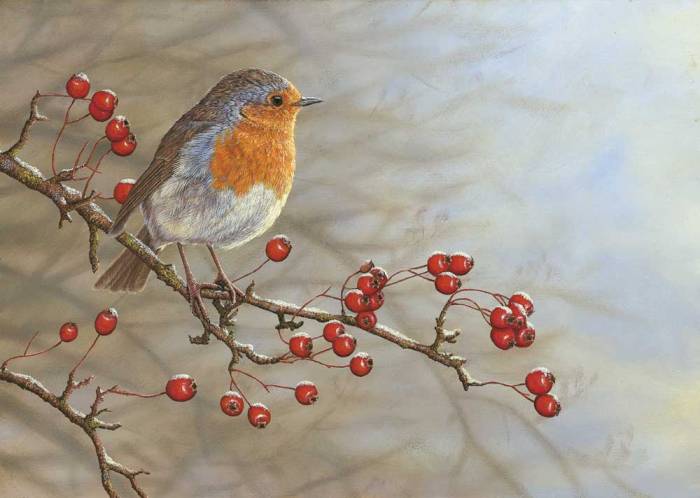 Goldcrest on Larch, art print from a painting by Robert E Fuller. Click to view and buy.
Goldcrest on Larch, art print from a painting by Robert E Fuller. Click to view and buy.Each species has a unique strategy to tackle inclement weather. Some birds confront the issue head on. Robins, woodpeckers and nuthatches are territorial. These birds are ferocious in the way that they defend their patch to maximise their own food supply. Others, like finches and sparrows, have a more gangland mentality. They gather up into large flocks, or family groups, and help each other by sharing their knowledge on best places to feed and roost. Many eyes are handy when a hungry sparrow hawk cruises by.
 Robin on Hawthorn, art print by Robert E Fuller. Click to buy
Robin on Hawthorn, art print by Robert E Fuller. Click to buyThe thrush family, which includes blackbirds, song and mistle thrushes, all share similar diets. Their menu switches from insects and worms, to winter berries and fruit. It’s a diet that is shared by many species and sometimes supplies can soon be exhausted.When the going gets really tough, blackbirds have been recorded taking meat from carcasses, stealing fish out of ponds and even searching through dung for beetle larvae.
Meanwhile song thrushes are partial to high-energy emergency rations, such as snails. They often break these open by smashing them on the garden path or they’ll use a favourite rockery stone as an anvil. The broken shell remnants then attract other birds such as dunnocks and wrens, to clean up the song thrushes’ spills. Mistle thrushes are the largest of the thrush family and a pair will take possession of a tree or shrub with plentiful and long lasting berries, such as a holly or pyracantha, and guard it from intruders throughout the winter. These plucky birds will even take on wood pigeons if they dare to approach their personal larder. This strategy normally works well, but can come unstuck when field fares and redwings migrate in from Scandinavia in flocks of up to several hundred strong.
 Fieldfare on Apples, painted by Robert E Fuller
Fieldfare on Apples, painted by Robert E FullerField fares are similar to mistle thrushes, whilst redwings are a smaller bird. Both are nomadic and solve their winter food problem by simply flying into an area and moving on when the food supply is depleted. Click to read about how I cater for these Nordic raiders in my own garden.
Mistle thrushes will still courageously try and fend off these immigrants, but they don’t have a hope against such large numbers. A large holly tree, which would last a pair of mistle thrushes the whole season, can be stripped bare in a matter of minutes by these marauding Scandinavian flocks.
Because nuthatches and jays feed on acorns and nuts, they don’t have long to gather in their supplies before they get lost in leaf litter or are spoiled. These birds hide their stash in secret places, but the technique relies on hard work and a good memory.
 Nuthatch, art print. Click to buy
Nuthatch, art print. Click to buyIt is our smallest birds that are under the greatest pressure in cold weather. They need to eat 30% of their body weight each day just to survive and so spend every waking moment searching for food. They only have seven to eight hours of daylight in which to do so, so the strain is considerable. The goldcrest is the smallest British bird. At only 9 cm, it weighs in at 5-7 grams, that’s just the weight of a 10p coin! This bird mainly operates in family groups, each keeping in touch with the other via constant contact calls, and all searching tirelessly through conifer foliage for minute insects and larvae. Goldcrests rarely visit bird tables so there isn’t a lot we can do to help them out during bad winters.
But one small bird we can assist is the wren. People often, mistakenly, believe wrens are our smallest birds, but in comparison to goldcrests and firecrests, they are heavyweights, coming in at 8-13 grams and measuring 10cm. Wrens suffer tremendously in harsh winters. But you can get them through a particularly cold snap by feeding them mealworms and grated cheese, preferably in a quiet place away from the hustle and bustle of the bird table. Coal, marsh and willow tits get bullied by larger great and blue tits and are often forced to surrender their food. For this reason their visits to the bird table are very brief.
 Jenny Wren, art print. Click to buy
Jenny Wren, art print. Click to buyThe moment they arrive at the table, they snatch some food and fly off immediately to either eat it or store it out of sight of these bully boys. Mission accomplished, they return to the table for another dash and grab. Feeding your garden birds really can help them through the winter and of course it’s great fun to watch a busy feeding station. It certainly beats watching TV. A wide variety of foods is what you need to attract the greatest variety of species. I’ve been feeding my own garden birds religiously for the past 11 years now and have gradually built up my ‘species list’ to 59. Click here to read about how I designed and planted my garden to help these species along all year round.
My next exhibition opens on November 4th-26th. I'll be exhibiting my collection of paintings of wildlife in winter. Click the link below to read all about it and see my newest paintings.
https://www.robertefuller.com/my-christmas-exhibition-will-focus-on-wildlife-in-winter/














